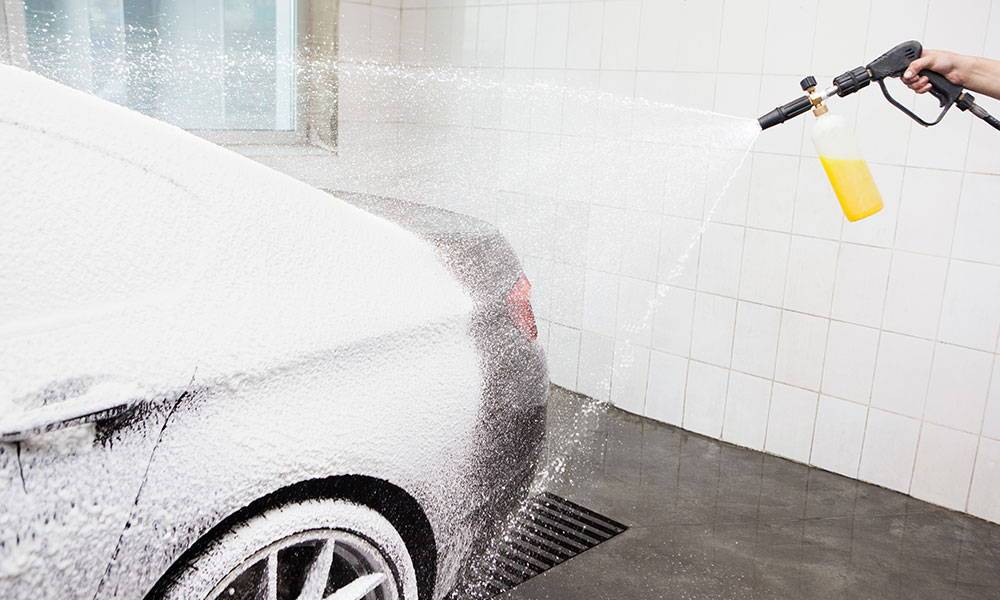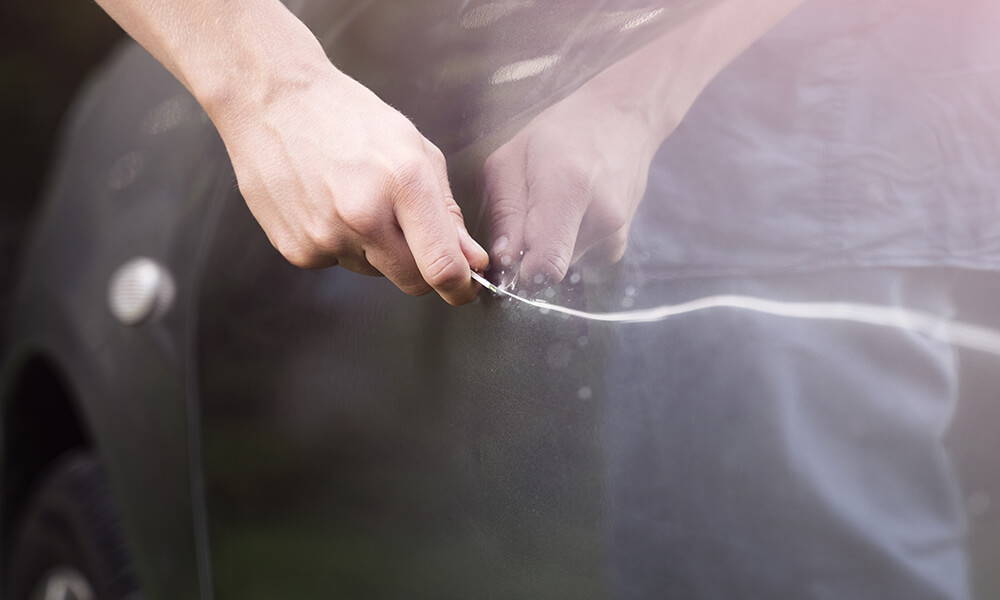Foam cannons make the car washing process more fun, and they also help you achieve great results when cleaning your car. With the help of a pressure washer, you can get them to spray thick, shaving cream-like foam onto your car that’s easy to work with. Plus, if you’re like most people, you probably associate thicker foam with stronger cleaning power.
This guide endeavors to demystify foam cannons and how they ought to be used.
★★★★★ "Saw this being promoted on a big YouTube channel and thought why not try it. Was a bit skeptical but WOW. Super easy to apply and car is shining. Water still pelts off 3 weeks later! Gonna ditch the wax and will continue to use." - Josh S.
What Is A Pressure Washer Foam Cannon?
A pressure washer foam cannon is basically a purposefully-designed canister with nozzles at the top that enable you to hook it to a pressure washer and an extension wand. With the help of the pressurized water from the pressure washer, the foam cannon mixes soap, water, and air in a way that produces thick suds that stick to the surface when they land on your car.
Does Foam Really Work?
Yes, foam works. The surfactants in car soaps that are designed for foam cannon use reduce surface tension, making it easier for soap and water to mix with air in the foam cannons. The generated foam achieves a thick and clingy consistency, making it sit on your car’s surface for longer. As a result, the cleaning detergent in the soap gets more time to break down and loosen dirt and grime.
On its own, the foam has little cleaning power. Simply put, it’s just the product of a reaction between air, water, and soap - more foam does not translate to more cleaning power. It’s the detergent in the soap that does the actual cleaning.
However, it’s worth noting that foam helps to lubricate the car’s surface, and in so doing, helps to prevent the formation of swirls when you’re washing the car’s surface with wash mitts.
Construction Of A Foam Cannon
A foam cannon has a wide-based transparent canister (mostly plastic) with volume labels that enable you to check the amount of soap and water it contains.
A suction tube draws the soap and water mixture inside the canister up to a brass connector that sits on top of the cannon. On one side of the brass connector is a quarter-inch quick connection plug that connects to your pressure washer gun. On the opposite side of the connector is an adjustable nozzle control knob, and on top of the connector is a soap control knob - both knobs are usually covered with plastic sheaths.
★★★★★ "Saw this being promoted on a big YouTube channel and thought why not try it. Was a bit skeptical but WOW. Super easy to apply and car is shining. Water still pelts off 3 weeks later! Gonna ditch the wax and will continue to use." - Josh S.
Foam Cannon Vs. Foam Gun: Which Should You Get?
It ultimately depends on the availability of a pressure washer. Foam cannons and foam guns are different in the fact that the former are designed to connect to pressure washers, while the latter are designed to connect to garden hoses. Compared to garden hoses, pressure washers deliver higher pressure and higher volumes of water, and so foam cannons tend to produce thicker soap suds in higher volumes.
Everyone wants those thick soap suds for their cars, so if you have access to a gas-powered or electric pressure washer, invest in a foam cannon. However, if you don’t have a pressure washer, you can still spray a considerable amount of foam onto your car with a good-quality foam gun. As discussed above, thicker foam does not translate to greater cleaning power, so a foam gun can be just as effective in helping you to clean your car.
How To Use A Foam Cannon
A foam cannon is a relatively straightforward piece of car washing equipment. You just unscrew the canister, pour soap and water into it, screw the canister back onto the brass connector, and swirl the soap and water around to mix it (don’t shake it vigorously). After that, attach your pressure washer gun to the foam cannon’s quarter-inch quick connection plug, adjust the soap control and nozzle control knobs, and spray your car with foam.
The Preflight Checklist: What You Should Know
The Pressure Washer - Type And Settings
All pressure washers are not made equal. Both gas-powered and electric pressure washers are effective in pumping out high volumes of water, but gas-powered pressure washers tend to have higher GPM and PSI ratings, making them preferred by many.
GPM (gallons per minute) is a measure of the amount of water that’s pumped out of a pressure washer. PSI (pounds per square inch), on the other hand, is a measure of the energy or pressure with which the soap and water that’s been pumped through your foam cannon will fit the surface of your car. Higher GPM and PSI ratings translate to better, thicker foam.
It’s recommended that you get a pressure washer with a GPM of at least 1.75 and a PSI rating of at least 1,900.
The Foam Cannon - Brand And Settings
Foam cannons come in different brands, some cheap and some expensive. Does the cost of a foam cannon determine its effectiveness? Not really. A $10 foam cannon can produce foam just as well as a $90 foam cannon. The cost difference is mainly seen in the quality of construction. Pricier foam cannons tend to have stouter brass connectors and better-built soap control and nozzle control knobs, and so these tend to last longer.
Here’s how a foam cannon is configured. The soap control knob controls the amount of soapy water that’s siphoned through the suction tube to be mixed with the water from the pressure washer. Adjusting it to one side reduces the amount of soap that’s siphoned up, resulting in a more watery output. As you can imagine, adjusting it the other way draws up more soap for a thicker, foamier output.
When the nozzle control knob is at its most open setting, the foam cannon delivers a thick stream of foam to a small surface area, while adjusting the nozzle control knob the other way tightens the exit point and causes the foam to spread out and cover a larger surface area as it sprays.
Water Source
Many car owners don’t realize just how much water affects the thickness or frothiness of the foam that a foam cannon produces. The water that comes out of your tap is high-mineral-content water (also called hard water). This is proven by the fact that tap water leaves water spots when it dries on a car’s surface. When hard water mixes with soap, the minerals in the water fight the active ingredients in the soap. As a result, the chemicals in the soap fail to fully break down as they’re supposed to, meaning less foam is generated.
Hose filters help to remove some of the minerals in tap water, so filtered tap water may generate more foam. For the best results, however, use distilled water. It doesn’t have any minerals and so won’t hinder the foaming process in any way.
Car Soap Vs. Specialized Foam Cannon Product: Which Produces Better Suds?
It’s worth noting that you should use car wash soaps that are specifically designed for foam cannon use, as not all car soaps produce thick suds. Yes, regular car soap can produce a considerable amount of foam, but it can’t compare with the copious amounts of foam that a specialized foam cannon soap product can produce.
Mixing Ratio
Don’t simply pour a liberal amount of soap into the foam cannon’s canister and mix with water - you’ll waste valuable product that way. Instead, use the mix ratio specified on the car soap container. All soaps are made differently, so the soap-to-water mixing ratios of different car soaps tend to vary. If the mixing ratios aren’t indicated, start with a 1:16 ratio (one part soap to sixteen parts water). If you feel the foam is too watery, continue adjusting the ratio until you get an ideal soap-to-water mixture.
Pre-Rinse Vs. Foaming Dry
Many argue that pre-rinsing your car before spraying foam onto it isn’t necessary, but pre-rinsing does have its advantages.
When you pre-rinse your car, you remove and loosen dirt and bits of debris, making it easier for the detergent in the foam you spray after that to break down and lift dirt and grime from the car’s surface.
Foaming dry can also work, but you’re assured of better results if you pre-rinse the vehicle.
Materials Needed
-
Decon Soap Kit for a powerful cleansing wash. Otherwise, for mega suds you would be better off using a traditional snow foam product.
- Several microfiber towels
- Pressure washer
- Foam cannon
NB: To keep the foam from evaporating quickly, don’t clean the car in direct sunlight or when it’s hot outside. Instead, do it in a garage, a shaded area, or when it’s cool outside.
Step 1.) Pre-Rinse
Using your pressure washer, hose down your car, working from top to bottom. After hosing down all the sides of the car, wait a few minutes to allow the moisture to soften the dirt and grime.
Step 2.) Spray The Foam
Pour your specialized foam cannon car soap into the foam cannon canister to the recommended level, then add the recommended amount of water. Swirl the bottle around to mix the soap and water. After that, screw the canister back onto the brass connector, attach your pressure washer gun to your foam cannon’s quarter-inch quick connection plug, and adjust the soap control and nozzle control knobs accordingly. Finally, spray the foam onto your car liberally, again working from top to bottom and ensuring that every square inch is covered with a generous amount of foam. Once you’re done, wait a few minutes as the foam further loosens and emulsifies dirt and grime.
Step 3.) Rinse The Car
To wash off the dirt that the foam has loosened, set the pressure washer gun to produce a narrow stream of water at high pressure and then hose down the car, working from top to bottom. Spray slowly from left to right (or right to left), ensuring that you wash off all the foam and dislodge all visible bits of dirt.
Foam Cannon Vs. Hand Wash (Two-Bucket Method)
The tried and true two-bucket hand wash method is widely recommended in the auto detailing industry, but you can get your car just as clean when using a foam cannon.
Advantages Of Using A Foam Cannon
Makes It Easier To Clean Your Car
You’ll just be holding up your foam cannon, pressure washer gun, and extension wand when spraying foam onto the car and rinsing it off, so it won’t tire you out as much as the two-bucket method does.
Takes Less Time
With a good-quality foam cannon and pressure washer, going over every surface and crevice of your car will take you less than a minute.
Better Lubrication And Less Chance Of Scratching
When thick foam is sprayed onto a car’s surface, it lifts and encapsulates the bits of dirt on top, therefore helping to prevent swirls and scratches when you use wash mitts to wash off dirt.
Less Soap And Water Required
A foam cannon enables you to spray just enough foam to cover the surface of your vehicle, and so it helps you to avoid using excessive amounts of soap and water in the cleaning process.
Comes In Handy When There’s Abrasive Material On The Car’s Surface
When abrasive materials like wildfire ash get on your car’s surface, you shouldn’t wash your car the conventional way because the abrasive material can severely scratch your paint. A foam cannon can help you to do a contactless wash to safely remove the abrasive material.
Advantages Of Using The Two-Bucket Method
This method reduces the transfer of bits of dirt and debris from one section of the car to another. In doing so, it helps to prevent swirls and scratches when washing the car.
The items required are available to most people, i.e. just two buckets and a wash mitt.
Compared to a foam cannon wash, a two-bucket wash’s main advantage is a more thorough clean.
Combining A Foam Cannon With The Two-Bucket Method
Most auto detailers recommend using the foam cannon wash as a pre-wash and the two-bucket method as the main wash. This method works because it ensures a super-clean, scratch/swirl-free finish. The foam cannon wash removes a considerable amount of dirt (especially large bits of dirt and debris), while the two-bucket wash then further cleans the surface, removing any remaining dirt and grime without scratching it.
However, it’s possible to combine a foam cannon with the two-bucket method. You pre-rinse your car, spray it with foam, and use the two-bucket method to wash the different sections of your car’s exterior. You then rinse your car with plenty of water and dry it off using a leaf blower or microfiber towels.
Rinseless Wash Products
If you don’t want to deal with water when washing your car, you can always try a waterless car wash product. Torque Detail’s Turbo Waterless Detailer is a fine example. You simply spray it onto the surface of your car, give it a few minutes to emulsify the dirt, then wipe it off using microfiber towels.
Cleaning And Storing Your Foam Cannon
After you’ve completed your foam cannon car wash, don’t leave the remaining soap mixture in the foam cannon. It’s likely to break down and form unsightly deposits when left in the canister for a long period, so you need to pour out the leftover soap mixture. After that, pour clean water into the foam cannon, attach the foam cannon to your pressure washer gun, and spray the water onto the ground for a few seconds. Doing this helps to push out all the remaining soap in the suction tube and nozzles. After that, pour out the water and store the foam cannon in a clean, dry place.
★★★★★ "Saw this being promoted on a big YouTube channel and thought why not try it. Was a bit skeptical but WOW. Super easy to apply and car is shining. Water still pelts off 3 weeks later! Gonna ditch the wax and will continue to use." - Josh S.
Bottom Line
It’s worth your while to learn better ways of using your foam cannon, and this isn’t just for professional detailers. Also, with a strong pressure washer, the right soap-to-water mixing ratio, soft water, and a high sudsing car wash soap, you may achieve foam thickness that you never thought possible.
The good news is that the more you use your foam cannon, the more you learn how to adjust all these different parameters to get better results.
Investing in a pricier, higher-quality foam cannon is the way to go, especially for professional detailers, as the equipment will last longer and may even improve the quality of your foam output.







